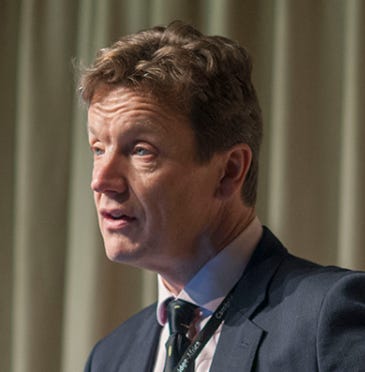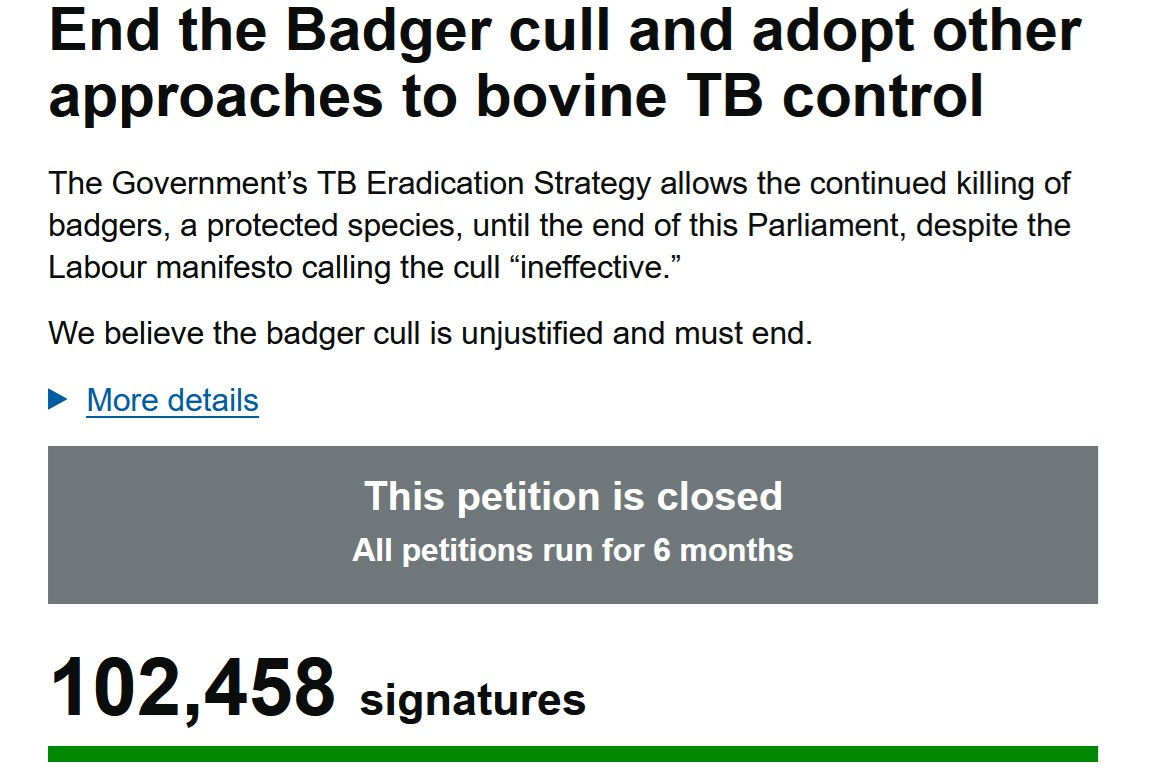The badger cull strategy, based on the results of the 1998 – 2005 Randomised Badger Control Trial (RBCT), put the wheels in motion for the widespread killing of badgers that has occurred over the last decade.
Pushed by Defra and the NFU as the best way to control Bovine TB – a disease now widely acknowledged as spread by cattle to other cattle – the ‘strategy’ divided the country into three different bTB management zones. Killing badgers was greenlit in over 70 areas of England. Since 2013, hundreds of thousands of badgers have been killed.
The current Labour government came into power acknowledging that the cull was ‘ineffective’ and vowing to bring it to an end. In June this year, Natural England approved nine supplementary licences for culls.
Yet, all the evidence shows that culling DOESN’T work. That should come as little surprise after an explosive re-evaluation of the RBCT by Prof Torgerson et al showed that when “more plausible approaches” to data analysis are used, the RBCT data strongly suggest that “there is no effect” of culling on bTB in cows.
As we wrote in December 2024, “Imagine this: for decades, an entire government policy causing mass death is founded on evidence that many scientists now say is deeply flawed. Like the infamous Post Office scandal, where innocent workers were blamed for crimes they didn’t commit, the badger cull hinges on a narrative that points the finger at badgers for spreading bovine tuberculosis (bTB) to cattle. The result? Over 230,000 badgers, a protected species, slaughtered since 2013 in what some researchers are now calling an unnecessary and misguided campaign.”
Frantic face-saving has been taking place amongst the coterie of Oxford academics on whose recommendations the slaughter of badgers took place. They have put their faith in a review of the ‘evidence’ by Professor Charles Godfray that was supposed to have justified the use of RBCT data to determine culling strategy. Godfray was reappointed to lead the review despite his role in the previous 2018 review that gave cover for culling to continue.
Godfray has now reported back, and a blog posted on The Badger Crowd has torn the results to shreds. In the blog they reveal ‘a major howler’ and confirmed that “badger culling would never have been sanctioned if the RBCT had got its statistics correct back in 2006”.
Once again, the government’s badger cull ‘policy’ has been shown to be an utter mess. A quarter of a million badgers have been killed, and England is littered with the corpses of badgers who don’t have Bovine TB and aren’t to blame for spreading the disease anyway.

The long-awaited ‘Godfray’ report, a review of scientific evidence since 2018 concerning bovine TB in cattle, was published on 4th September. Commissioned by Defra, it is supposed to feed into a ‘comprehensive new bovine TB strategy’ that was announced in August 2024 by the incoming Labour government. It is the science that the new policy should be based on, so it is an important – and needs to be sound.

Chapter 6: The Disease in Wildlife focuses on badgers. The report does not deal head-on with the Royal Society Open Science pre-publication review by Prof Mark Brewer. This claimed that models suggesting ‘badger culling works’ were ‘naïve at best’. Instead, a newcomer to the issue, statistician Prof Bernard Silverman (a colleague of Christl Donnelly at Oxford University) has tried to rescue the situation & restore statistical validity to show some positive disease benefit.

Silverman presents a new set of models. He confirms (para. 65) in a massive ‘wake-up’ finding that a paper by Prof Torgerson’s study group in June of this year did show that the key 2006 RBCT paper by Donnelly and others, in short, got the modelling wrong. This has massive implications for a wide number of papers that have used that paper’s calculations to build further models. It must cause a tsunami of scientific correction, or the retraction of dozens of publications that have been used to promote badger culling over the last 20 years. This is potentially one of the biggest shake-up’s in biological science, for a generation. The ‘perturbation effect hypothesis’ evaporates, for example.

Instead of the huge significance claimed in 2006 for badger culling, Silverman has tried to produce a model that ‘just about’ finds an effect from badger culling, providing ‘weaker evidence for a positive effect’. But nevertheless, at first glance, it might save Oxford’s blushes. The problem is that he gets to this position in a manner that is both unconvincing, and incorrect.

Firstly, there has been Godfray ‘science’ report simply adds to the bovine TB chaos. Not just from Silverman but the two peer-reviewers asked to check his models, and Defra officials who supervised the process. Annex 4 of the Godfray report outlines the binomial model he has used, but gives the wrong information criteria (ic) outputs. These are standard applications that test how well the model fits the data. He claims to have used what is called Akaike, but instead presents Bayesian outputs. One assumes that this was not intentional, but rather a transcription error.
However, in addition to this, he has failed to address the fact that for binomial models with small sample sizes (the RBCT was an experiment with a small sample size – just ten paired comparisons), his binomal approach should have used a particular type of Akaike information criteria. When applied, results suggest that models showing a benefit from badger culling are those least supported. The best supported models are those that do not include badger culling, indicating badger culling had no effect. Even if he had decided that the Bayesian approach was the correct way to evaluate the models, the small sample size variant should have been used and this too makes badger culling the wrong model to favour from a statistical, hence scientific perspective.
So any ‘merit on both sides’ of the current modelling debate, the football equivalent of a score draw, does not apply as he had hoped. Torgerson’s analyses win handsomely on penalties and the RBCT is relegated.
The implications of a flawed report to the Minister are huge for Defra and Godfray, who chose Silverman to try to rescue the unsavable. It looks such a crude attempt that the new Minister (Zeichner has now gone) will have some difficult explaining to do. Do farmers get their money back for doing something pointless for the last 12 years, and do wildlife charities get compensation for rightly fighting, at huge cost, a scientifically botched policy? It’s going to be interesting. And if culling doesn’t work, neither will badger vaccination or TVR, which appears to be Defra’s new direction of choice. The second Godfray report could potentially be seen as a back-covering exercise to try to protect Oxford University, but it has not succeeded.
This is grounds for a major inquiry, with standards of scientific integrity and the impartiality of appointments under the spotlight. Badger culling would never have been sanctioned if the RBCT had got its statistics correct back in 2006.
- (Edited for length, the full version of this article can be found on The Badger Crowd blog.)

In November 2024 Protect the Wild launched a government petition calling on the government to end the Badger cull and adopt other approaches to bovine TB control.
Our petition passed the 100k signatures needed to trigger a parliamentary debate in May, and we have been told in the last few weeks that a debate has been scheduled for 13 October 2025.
We welcome the opportunity. The government must be challenged over its decision to continue killing badgers in the face of mounting evidence that doing so is irrelevant to tackling bTB in cows.
What has Protect the Wild been doing to tackle the cull?
- We called on the Labour government to honour its promise to stop the badger cull. Over 100,000 badger supporters signed the petition and a parliamentary debate is scheduled for 13 October 2025.
- We commissioned a series of powerful animations designed to highlight the cruelty and futility of the badger cull that have been viewed millions of times.
- Through our Equipment Fund we have been providing trail cams and night vision optics to front-line groups taking direct action in the field to protect badgers.
- We’re syndicating the blog posts of the Badger Crowd – a team of specialised ecologists and scientists who focus on badgers and the cull.
- We created Protectors of the Wild, a free resource that looks in detail at the laws protecting badgers and other animals. Protectors explains how we can Recognise, Record, and Report wildlife crime and help stop them taking place.

